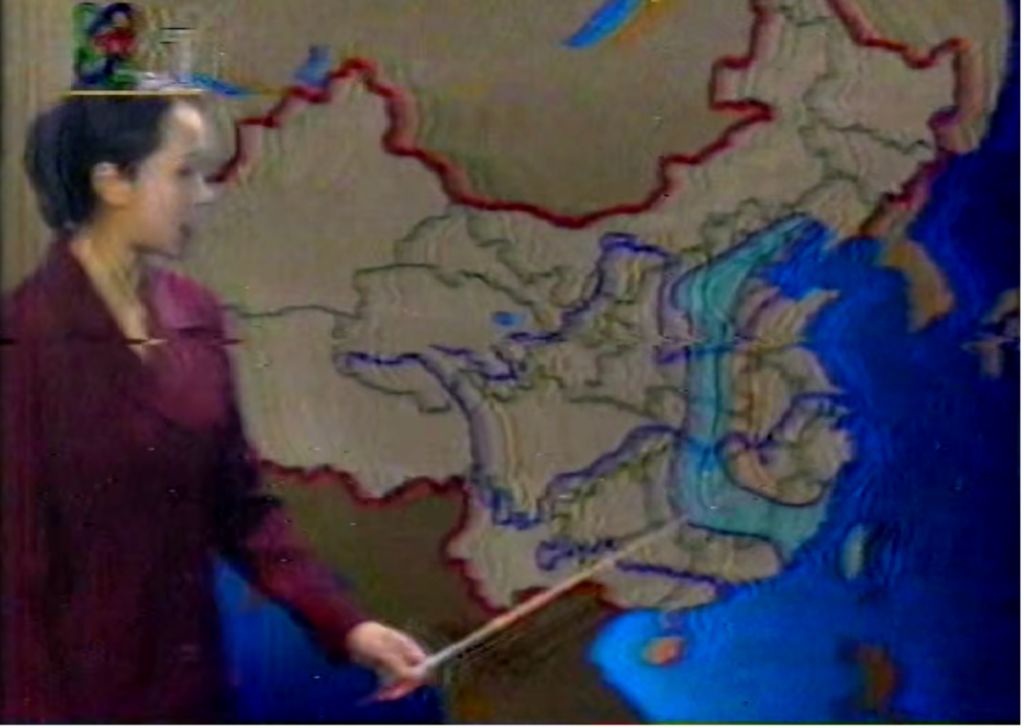In China, the most-watched TV news program, News Simulcast (Xinwen Lianbo), usually ends with another daily show, the Weather Report (Tianqi Yubao). Launched in 1980, Tianqi Yubao is co-produced by CCTV and the National Meteorological Center (CMN, 2020). The broadcaster, in understandable descriptions, presents the forthcoming weather conditions nationwide. In the 1980s, Tianqi Yubao provided Chinese audiences with useful information by making animation, including animated maps and symbols referring to different weather conditions, to predict weather that influenced peoples’ daily life. While most of the current research on Chinese animation pays attention to films made by the Shanghai Animation Film Studio, the animated effects in Tianqi Yubao remain under-examined. In addition, the manner in which the broadcaster interacts with the animated effects is neglected. This post argues that the broadcaster of Tianqi Yubao acts as an animator. S/he plays with the animated background and, thus, such interactions create a visual effect on screen that guides audiences to watch the images animated by the broadcaster.
Initially, the map in Tianqi Yubao was manually drawn, and lightbulbs were set up behind it. If the broadcaster pointed at Beijing, the city name on the map would light up (CMN 2020). TV audiences would watch an animation in which the presenter activated the map by highlighting the city (Figure 1). According to Tom Gunning, such images can be categorized into “animation” that is “shared by all cinematic moving images” (Gunning 2014). The animation in early Tianqi Yubao indicates a more intriguing perspective in understanding animation. The animated map and lightbulbs were manually set and controlled during the show. Yet, the TV image merged into flattened moving images and forged an effect as if the broadcaster was live when the entire map board plus the broadcaster were compassed on the screen.
In addition to the body gesture, the broadcaster’s voice also engages with the animating procedures, embodying the presence of the broadcaster even if he or she is not onscreen. Mary Ann Doane (1980) suggests that voice-over commentary is a “disembodied voice,” for it is presented as outside of the space. In Tianqi Yubao, however, the map and signs on it are animated with the broadcaster’s synchronized narration. Therefore, voice acting, including voice-over, contributed to the acting of the broadcaster-animator in Tianqi Yubao by enriching the animated space.
In 1985, Tianqi Yubao replaced the handmade background with the animation of satellite cloud imagery, which was recorded and played on-air (CMN 2020, Figure 2). The roles of the broadcasters did not change, while their mission as animators was reshaped by the new technology. When the broadcaster does not show up on the screen, the voice still navigated audiences through the animated images. However, when the broadcaster does appear, there is nothing behind him or her – no map, no bulbs – only a green screen left for technicians to do the cut-out. In other words, the handmade background was replaced by digital animation.
As such, the broadcasters renewed their way of playing with the background. From this moment, they started to act as if they could see the map (Figure 3). Like the animated satellite cloud imagery, the digital animation displayed a map of China. Since the map was presented in the form of animation, with animated symbols of sun, cloud, wind, and rain cycling mode on the screen, the broadcasters’ acting was not only to address the audience but also to animate the map by their performance of supposition.
The usage of digital animation became common in Tianqi Yubao in the 1990s. In 1993, the role of weather broadcaster was officially acknowledged and underlined by CCTV (CMN 2020). “Mr. Weather” (Tianqi xiansheng) Song Yingjie and “Ms. Weather” (Tianqi xiaojie) Yang Dan became two rising TV stars. Watching their performance has become a daily routine, and they continue to act and inform audiences by engaging with animation.
In Tianqi Yubao, like in most weather forecast programs, it is the broadcaster who acts as the animator to “make” the map move. Also, both the broadcaster-animator and the animated effects are compassed into moving images, which create a hybrid form of animation plus live action on TV. Moreover, Tianqi Yubao was launched when TV began to be popular in China in the 1980s. In other words, it has grown up with Chinese audiences for four decades. Thus, animation in Tianqi Yubao is useful not only because of the information told through the animated effects, but also due to the process to mediate animation on a public TV program by the broadcaster-animator, who shows up after dinner every day and leads the audiences to another day of sun, cloud, rain, or snow.
References
CMN (2020), ‘Companion despite cold or warm, wind or rain: 40 years of the Xinwen Lianbo Weather Forecast’, China Meteorological News.
Doane, Mary Ann (1980), ‘The Voice in the Cinema: The Articulation of Body and Space’, Yale French Studies, 60, pp. 33-50.
Gunning, Tom (2014), ‘Animating the Instant: The Secret Symmetry between Animation and Photography’, Animating Film Theory, edited by Karen Beckman, Durham: Duke University Press.
Muyang Zhuang is a Ph.D. candidate in the Division of Humanities at the Hong Kong University of Science and Technology. His research interests include film studies, modern Chinese art history, and visual culture in East Asia, with a special focus on cartoons and animation.



